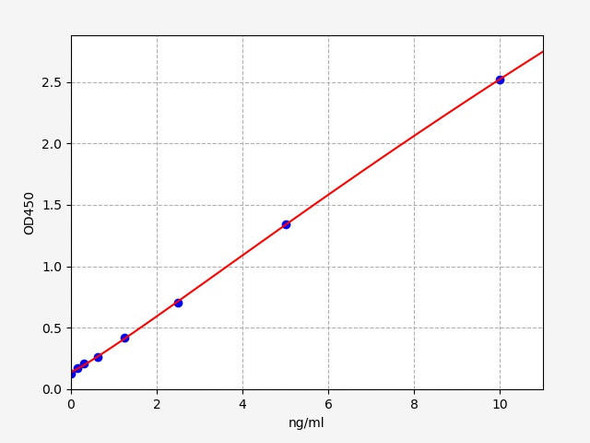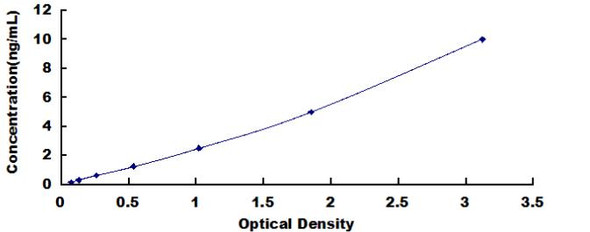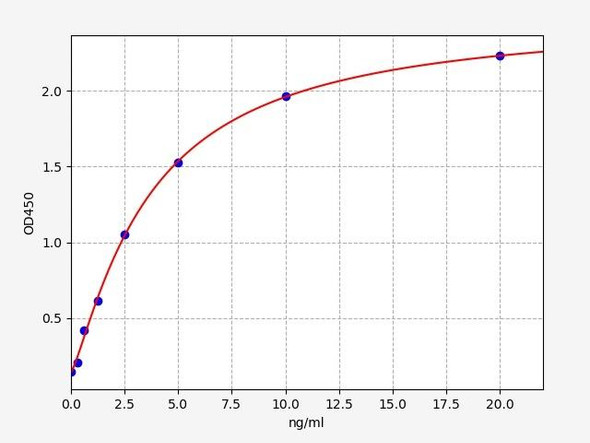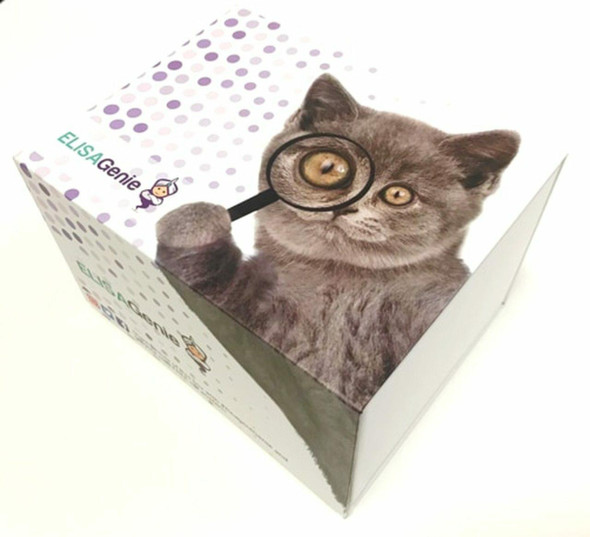Human NLRC4(NLR family CARD domain-containing protein 4)ELISA Kit (HUES03570)
- SKU:
- HUES03570
- Product Type:
- ELISA Kit
- Size:
- 96 Assays
- Uniprot:
- Q9NPP4
- Sensitivity:
- 46.88pg/mL
- Range:
- 78.13-5000pg/mL
- ELISA Type:
- Sandwich
- Reactivity:
- Human
- Sample Type:
- Serum, plasma and other biological fluids
- Research Area:
- Cell Death
Description
Human NLRC4 (NLR family CARD domain-containing protein 4) ELISA Kit
The Human NLRC4 (NLR Family, CARD Domain Containing Protein 4) ELISA Kit is specifically designed for the accurate measurement of NLRC4 levels in human samples including serum, plasma, and cell culture supernatants. This ELISA kit offers high sensitivity and specificity, ensuring precise and reliable results for a variety of research applications. NLRC4 is a critical component of the innate immune system, functioning as a sensor of intracellular pathogens and triggering inflammatory responses.
Dysregulation of NLRC4 has been implicated in various inflammatory and autoimmune diseases, making it an important biomarker for studying these conditions and potentially developing targeted therapies. The Human NLRC4 ELISA Kit from AssayGenie provides researchers with a valuable tool for investigating the role of NLRC4 in health and disease. Order yours today and advance your research efforts in the field of immunology and inflammation.
| Assay type: | Sandwich |
| Format: | 96T |
| Assay time: | 4.5h |
| Reactivity: | Human |
| Detection Method: | Colormetric |
| Detection Range: | 78.13-5000 pg/mL |
| Sensitivity: | 46.88 pg/mL |
| Sample Volume Required Per Well: | 100µL |
| Sample Type: | Serum, plasma and other biological fluids |
| Specificity: | This kit recognizes Human NLRC4 in samples. No significant cross-reactivity or interference between Human NLRC4 and analogues was observed. |
This ELISA kit uses Sandwich-ELISA as the method. The micro ELISA plate provided in this kit has been pre-coated with an antibody specific to Human NLRC4. Standards or samples are added to the appropriate micro ELISA plate wells and combined with the specific antibody. Then a biotinylated detection antibody specific for Human NLRC4 and Avidin-Horseradish Peroxidase (HRP) conjugate are added to each micro plate well successively and incubated. Free components are washed away. The substrate solution is added to each well. Only those wells that contain Human NLRC4, biotinylated detection antibody and Avidin-HRP conjugate will appear blue in color. The enzyme-substrate reaction is terminated by adding Stop Solution and the color turns yellow. The optical density (OD) is measured spectrophotometrically at a wavelength of 450 nm ± 2 nm. The OD value is proportional to the concentration of Human NLRC4. The concentration of Human NLRC4 in samples can be calculated by comparing the OD of the samples to the standard curve.
| UniProt Protein Function: | NLRC4: Key component of inflammasomes that indirectly senses specific proteins from pathogenic bacteria and fungi and responds by assembling an inflammasome complex that promotes caspase-1 activation, cytokine production and macrophage pyroptosis. 4 isoforms of the human protein are produced by alternative splicing. |
| UniProt Protein Details: | Protein type:Apoptosis Chromosomal Location of Human Ortholog: 2p22. 3 Cellular Component: cytosol; nucleus; spindle microtubule Molecular Function:ATP binding; cysteine protease inhibitor activity; identical protein binding; magnesium ion binding; protein binding; protein homodimerization activity; ubiquitin-protein ligase activity Biological Process: activation of innate immune response; activation of NF-kappaB transcription factor; caspase activation; defense response to bacterium; detection of bacterium; inflammatory response; innate immune response; interleukin-1 beta secretion; positive regulation of apoptosis; protein homooligomerization; regulation of apoptosis; regulation of signal transduction Disease: Autoinflammation With Infantile Enterocolitis; Familial Cold Autoinflammatory Syndrome 4 |
| NCBI Summary: | This gene encodes a member of the caspase recruitment domain-containing NLR family. Family members play essential roles in innate immune response to a wide range of pathogenic organisms, tissue damage and other cellular stresses. Mutations in this gene result in autoinflammation with infantile enterocolitis. Alternative splicing results in multiple transcript variants. [provided by RefSeq, Oct 2014] |
| UniProt Code: | Q9NPP4 |
| NCBI GenInfo Identifier: | 20138032 |
| NCBI Gene ID: | 58484 |
| NCBI Accession: | Q9NPP4. 2 |
| UniProt Secondary Accession: | Q9NPP4,Q96J81, Q96J82, Q96J83, A8K9F8, B2RBQ3, B3KTF0 D6W580, |
| UniProt Related Accession: | Q9NPP4 |
| Molecular Weight: | 10,646 Da |
| NCBI Full Name: | NLR family CARD domain-containing protein 4 |
| NCBI Synonym Full Names: | NLR family CARD domain containing 4 |
| NCBI Official Symbol: | NLRC4 |
| NCBI Official Synonym Symbols: | CLAN; IPAF; AIFEC; CLAN1; CLANA; CLANB; CLANC; CLAND; FCAS4; CARD12; CLR2. 1 |
| NCBI Protein Information: | NLR family CARD domain-containing protein 4 |
| UniProt Protein Name: | NLR family CARD domain-containing protein 4 |
| UniProt Synonym Protein Names: | CARD, LRR, and NACHT-containing protein; Clan protein; Caspase recruitment domain-containing protein 12; Ice protease-activating factor; Ipaf |
| Protein Family: | NLR family CARD domain-containing protein |
| UniProt Gene Name: | NLRC4 |
| UniProt Entry Name: | NLRC4_HUMAN |
As the OD values of the standard curve may vary according to the conditions of the actual assay performance (e. g. operator, pipetting technique, washing technique or temperature effects), the operator should establish a standard curve for each test. Typical standard curve and data is provided below for reference only.
| Concentration (pg/mL) | O.D | Average | Corrected |
| 5000 | 2.531 2.561 | 2.546 | 2.483 |
| 2500 | 1.638 1.666 | 1.652 | 1.589 |
| 1250 | 1.009 0.993 | 1.001 | 0.938 |
| 625 | 0.485 0.521 | 0.503 | 0.44 |
| 312.5 | 0.285 0.267 | 0.276 | 0.213 |
| 156.25 | 0.179 0.165 | 0.172 | 0.109 |
| 78.13 | 0.109 0.127 | 0.118 | 0.055 |
| 0 | 0.059 0.067 | 0.063 | -- |
Precision
Intra-assay Precision (Precision within an assay): 3 samples with low, mid range and high level Human NLRC4 were tested 20 times on one plate, respectively.
Inter-assay Precision (Precision between assays): 3 samples with low, mid range and high level Human NLRC4 were tested on 3 different plates, 20 replicates in each plate.
| Intra-assay Precision | Inter-assay Precision | |||||
| Sample | 1 | 2 | 3 | 1 | 2 | 3 |
| n | 20 | 20 | 20 | 20 | 20 | 20 |
| Mean (pg/mL) | 227.38 | 609.23 | 2069.62 | 242.64 | 637.84 | 1916.06 |
| Standard deviation | 12.30 | 30.95 | 68.09 | 16.18 | 32.34 | 68.79 |
| C V (%) | 5.41 | 5.08 | 3.29 | 6.67 | 5.07 | 3.59 |
Recovery
The recovery of Human NLRC4 spiked at three different levels in samples throughout the range of the assay was evaluated in various matrices.
| Sample Type | Range (%) | Average Recovery (%) |
| Serum (n=5) | 87-101 | 93 |
| EDTA plasma (n=5) | 85-98 | 92 |
| Cell culture media (n=5) | 93-108 | 100 |
Linearity
Samples were spiked with high concentrations of Human NLRC4 and diluted with Reference Standard & Sample Diluent to produce samples with values within the range of the assay.
| Serum (n=5) | EDTA plasma (n=5) | Cell culture media (n=5) | ||
| 1:2 | Range (%) | 93-105 | 85-95 | 86-100 |
| Average (%) | 100 | 90 | 92 | |
| 1:4 | Range (%) | 89-104 | 83-96 | 83-97 |
| Average (%) | 96 | 90 | 89 | |
| 1:8 | Range (%) | 90-103 | 79-93 | 86-98 |
| Average (%) | 97 | 86 | 93 | |
| 1:16 | Range (%) | 88-101 | 82-96 | 86-100 |
| Average (%) | 96 | 88 | 92 |
An unopened kit can be stored at 4°C for 1 month. If the kit is not used within 1 month, store the items separately according to the following conditions once the kit is received.
| Item | Specifications | Storage |
| Micro ELISA Plate(Dismountable) | 8 wells ×12 strips | -20°C, 6 months |
| Reference Standard | 2 vials | |
| Concentrated Biotinylated Detection Ab (100×) | 1 vial, 120 µL | |
| Concentrated HRP Conjugate (100×) | 1 vial, 120 µL | -20°C(shading light), 6 months |
| Reference Standard & Sample Diluent | 1 vial, 20 mL | 4°C, 6 months |
| Biotinylated Detection Ab Diluent | 1 vial, 14 mL | |
| HRP Conjugate Diluent | 1 vial, 14 mL | |
| Concentrated Wash Buffer (25×) | 1 vial, 30 mL | |
| Substrate Reagent | 1 vial, 10 mL | 4°C(shading light) |
| Stop Solution | 1 vial, 10 mL | 4°C |
| Plate Sealer | 5 pieces | |
| Product Description | 1 copy | |
| Certificate of Analysis | 1 copy |
- Set standard, test sample and control (zero) wells on the pre-coated plate and record theirpositions. It is recommended to measure each standard and sample in duplicate. Note: addall solutions to the bottom of the plate wells while avoiding contact with the well walls. Ensuresolutions do not foam when adding to the wells.
- Aliquot 100µl of standard solutions into the standard wells.
- Add 100µl of Sample / Standard dilution buffer into the control (zero) well.
- Add 100µl of properly diluted sample (serum, plasma, tissue homogenates and otherbiological fluids) into test sample wells.
- Cover the plate with the sealer provided in the kit and incubate for 90 min at 37°C.
- Aspirate the liquid from each well, do not wash. Immediately add 100µL of BiotinylatedDetection Ab working solution to each well. Cover the plate with a plate seal and gently mix. Incubate for 1 hour at 37°C.
- Aspirate or decant the solution from the plate and add 350µL of wash buffer to each welland incubate for 1-2 minutes at room temperature. Aspirate the solution from each well andclap the plate on absorbent filter paper to dry. Repeat this process 3 times. Note: a microplatewasher can be used in this step and other wash steps.
- Add 100µL of HRP Conjugate working solution to each well. Cover with a plate seal andincubate for 30 min at 37°C.
- Aspirate or decant the solution from each well. Repeat the wash process for five times asconducted in step 7.
- Add 90µL of Substrate Reagent to each well. Cover with a new plate seal and incubate forapproximately 15 min at 37°C. Protect the plate from light. Note: the reaction time can beshortened or extended according to the actual color change, but not by more than 30min.
- Add 50 µL of Stop Solution to each well. Note: Adding the stop solution should be done inthe same order as the substrate solution.
- Determine the optical density (OD value) of each well immediately with a microplate readerset at 450 nm.









